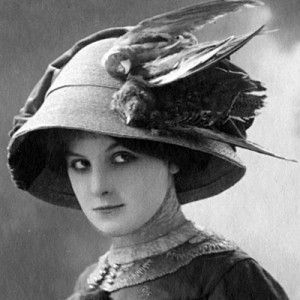PRESERVING THE PAST: Dresses for Everyone

In the latest Preserving The Past column, one of the big fashions in the 1890s was decorating hats with dead birds. This includes extinct birds, such as the Carolina Parakeet (shown above). [Photo courtesy of Pinterest]
This selection begins with what Alpha Owens wrote about clothing worn in the late 1890s. As I read about the work involved in just producing items for the family to wear, my fingers ached from holding the needle and my eyes stung from concentrating on the close work.
Owens titled her essay “Styles.”
“To begin with, all clothing was made at home. People who could afford it, had a seamstress or dressmaker come in twice a year and do the sewing.
Those who could not afford a seamstress had to make their own. They would maybe hire a dress now and then, which was made by local dressmakers.
Such a thing as buying a layette was never heard of. The expectant mother took great pride in being ready for the arrival by having an ample supply of everything the baby would need all prepared in advance. A woman who did not have things ready was considered a very shiftless person.
Women put a great deal of handwork on baby’s clothes although most women did have a treadle sewing machine for ordinary sewing. Fine tucks and dainty embroideries were the rule for baby clothing.
The christening gown was a masterpiece to be kept as a showpiece till the child was grown. All little babies wore long clothes. It was thought better in order to keep the little toes warm.
Any baby seen wearing nothing but a diaper was considered neglected.
Little boys wore dresses until about five years of age and in the summertime sunbonnets, the same as little girls. The women made and wore either slat bonnets or padded and starched stiff sunbonnets or pretty flowered hats.
Alas, sometimes they were trimmed with dead birds.
For Sunday school little girls carried parasols with flowered sticks and usually bright colored brocade cloth tops. When I got mine, a pretty light blue one, I had no idea how to carry it.
One direction was as good as another to me until my mother showed me how to look up to see when the sun could be seen through the top.
Then I’d know I had it right. Most little boys’ suits, pants, coats and overcoats were cut down out of the good parts from father’s or elder brothers’ pants or other garments. A pocket was a thing of joy to a little boy.
Boys and girls alike wore candy-stripe wool stockings, which always served when worn out for the stripe part of rag carpets. Such a thing as a little girl going with bare legs and an amputated stub of a skirt was never heard of and would have not been countenanced if she had appeared in one.”
I know Owens writing about little boys wearing dresses is true. My father was born in 1922 and I have a picture of him wearing a calf-length dress standing with his siblings. He was probably two at the time.
I also noticed how Owens used clothing as a way to form judgments of people, being shiftless without a prepared layette and barelegged girls being frowned upon. I wonder what her opinion would be of “onesies” and yoga pants.
The Calhoun County Museum houses many fine examples of the “dainty embroideries” Owens mentions. I imagine there are those of you who have heirloom-christening dresses tucked into tissue and lovingly placed in a drawer.
If you know this treasure was handmade, take time to get it out and marvel at the patient, skilled stitching and embroidery.
Category:
The Graphic-Advocate
The Graphic-Advocate
121 North Center St.
Lake City, IA 51449
Phone: (641) 456-2585
Mid-America Publishing
This newspaper is part of the Mid-America Publishing Family. Please visit www.midampublishing.com for more information.
